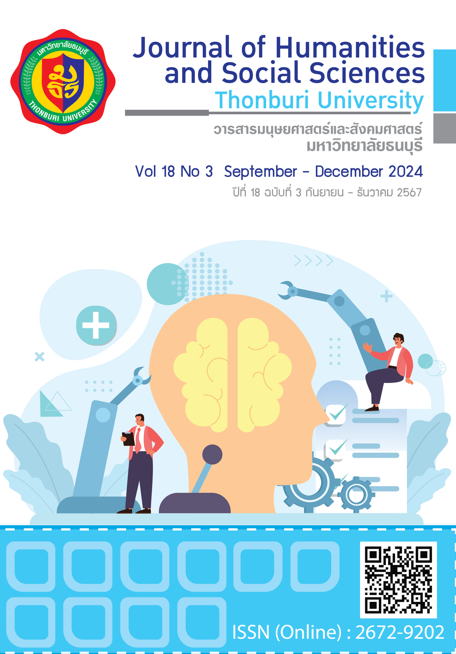Guidelines for teaching and learning development to promote the quality of vocational students in a new normal for Eastern Economic Corridor
Keywords:
teaching and learning, vocational education, new normal, eastern economic corridorAbstract
This study was to study a model for teaching and learning development to promote the quality of vocational students in a new normal age for Eastern Economic Corridor using document research divided into 2 steps: 1) document research to a model and 2) quantitative research is a quality assessment with 15 experts with an evaluation form. The results of the study found that the teaching and learning format that occurs will be managed in a manner "Management like educational institutions, factories, houses" by dual vacation training and must develop online teaching and learning for teachers in 3 issues: 1) time allocation to skills, 2) setting goals to develop online teaching, and 3) strengthening practical skills with business establishments. This allows students to be developed to be innovators through developing 3 skills: Cognitive Strategies, Problem-Solving Strategies, and Critical Thinking Skills, The entire process will be successful, those involved must participate, including: policy executives, administrators of vocational education institutions, establishment administrators, teachers, and parents and evaluation results Usefulness, correctness, and appropriateness The overall picture is at the highest level. The average values were 3.71, 3.71 3.64, respectively. The feasibility aspect was at a high-level average is 3.26.
References
กาญจน์ เรืองมนตรี; และ ธรินธร นามวรรณ. (2557). การบริหารวิชาการและนวัตกรรมการจัดการการเรียนรู้. พิมพ์ครั้งที่ 2. มหาสารคาม: อภิชาตการพิมพ์.
กิตติพันธ์ หันสมร และวรัทยา ธรรมกิตติภพ (2566). สภาพปัญหาและความคาดหวัง ในการจัดการเรียนการสอนระดับอาชีวศึกษาในพื้นที่เขตพัฒนาพิเศษภาคตะวันออกจากสถานการณ์การแพร่ระบาดไวรัส Covid-19. วารสารวิชาการ มหาวิทยาลัยหอการค้าไทย มนุษยศาสตร์และสังคมศาสตร์. 43(4): 101-120.
จินตนา รวมชมรัตน์. (2558). รูปแบบการจัดการอาชีวศึกษาระบบทวิภาคีในวิทยาลัยอาชีวศึกษาสังกัดสำนักงานคณะกรรมการการอาชีวศึกษา. ปรัชญาดุษฎีบัณฑิต. มหาวิทยาลัยราชภัฏกาญจนบุรี.
ณัฐวิทย์ มุงเมือง และบุญสม วราเอกศิริ. (2560). การพัฒนาความร่วมมือการจัดการอาชีวศึกษาระบบทวิภาคีของวิทยาลัยการอาชีพในภาคเหนือตอนบน. วารสารพิฆเนศวร์สาร. 13(1): 133 – 146.
ดวงนภา มกรานุรักษ์. (2554). อนาคตภาพการอาชีวศึกษาไทยในทศวรรษหน้า (2554-2564). ปรัชญาดุษฎีบัณฑิต, มหาวิทยาลัยขอนแก่น.
ธนนันท์ ธนารัชตะภูมิ, นารท ศรีละโพธิ์, ถวิกา เมฆอัคฆกรณ์ และอุษณี ลลิตผสาน. (2562). การอาชีวศึกษา: ทวิภาคี และทวิศึกษา. Veridian E-Journal, Silpakorn University. 12(6): 244-263.
บุญชม ศรีสะอาด. (2560). การวิจัยเบื้องต้น. พิมพ์ครั้งที่ 10. กรุงเทพฯ: สุวีริยาสาส์น.
ประชาชาติธุรกิจ. 2562. Roadmap แรงงาน EEC 1 ล้านคนป้อน S-curve ใน 12 ปีข้างหน้า. สืบค้นเมื่อ 3 เมษายน 2567, จาก https://www.prachachat.net/economy/news-315063.
สำนักงานคณะกรรมการการอาชีวศึกษา. (2564). เอกสารประกอบแนวทางการจัดการเรียนรู้อาชีวศึกษาในสถานการณ์การแพร่ระบาดของโรคติดเชื้อไวรัสโคโรนา 2019 (COVID-19). สืบค้นเมื่อ 9 สิงหาคม 2565, จาก http://bsq2.vec.go.th/document/covid/learning%20covidv2.pdf.
สำนักงานเลขาธิการสภาการศึกษา. (2560). แผนการศึกษาแห่งชาติ พ.ศ. 2560 – 2579. กรุงเทพฯ: พริกหวานกราฟฟิค.
สุเมธ รินทลึก และวิชิต แสงสว่าง. (2564). การจัดการอาชีวศึกษาระบบทวิภาคีสู่ความเป็นเลิศในสถานศึกษาสังกัดอาชีวศึกษาจังหวัดฉะเชิงเทรา. วารสาร มจร สังคมศาสตร์ปริทรรศน์. 10(3): 39-53.
สุรศักดิ์ ปาเฮ. (2561). การศึกษาออนไลน์: ทฤษฎีและวิธีปฏิบัติ. แพร่: แพร่ไทยอุตสาหการพิมพ์.
สุวิมล มธุรส. (2564). การจัดการศึกษาในระบบออนไลน์ในยุค new normal COVID-19. วารสารรัชต์ภาคย์. 15(40): 33-42.
Breslow, L., David, E. P., Jennifer D., Glenda. S. S., Andrew D. H. and Daniel, T. S. (2013). Studying Learning in the Worldwide Classroom Research into edX’s First MOOC. Retrieved September 12, 2020, from https://doi.org/10.1007/BF01173772
Breslow, L., et al. (2013). Studying Learning in the Worldwide Classroom Research into edX’s First MOOC. Retrieved September 12, 2020, from https://doi.org/10.1007/BF01173772.
Chen, B., et al. (2013). User Acceptance of Mobile Technology: a Campus-wide Implementation of Blackboard"s Mobile TM learn Application. Journal of Educational Computing Research, 49(3), 327–343.
Chen, B., Sivo, S., Seilhamer, R., Sugar, A. and Mao, J. (2013). User Acceptance of Mobile Technology: a Campus-Wide Implementation of Blackboard"s Mobile tm Learn Application. Journal of Educational Computing Research, 49(3), 327–343.
Chryssolouris, G., Mavrikios, D., and Rentzos, L. (2016). The teaching factory: A manufacturing education paradigm. Procedia CIRP, 57:44-48.
Ilyas, I.P., Semiawan, T. (2012). Production-Based Education (PBE): The Future Perspective of Education on Manufacturing Excellent. Procedia-Social and Behavioral Sciences, 52, 5-14.
Ismet P. Ilyas. (2001). Collaborative Engineering: Key Element for Integrating and Enterprising Education Institution. The International Symposium on Open and Distance Learning, Yogyakarta, 12-14 November 2001.
Joint Committee on Standards for Educational Evaluations. (1994). The program evaluation standards: How to assess evaluations of educational programs. Newbury Park, CA: Sage.
Mavrikios, D., and Rentzos, L. (2016). The teaching factory: A manufacturing education paradigm. Procedia CIRP, 57:44-48.
Saputro, H., I. Widiastuti and B. Harjanto. (2018). Production-based education model for improving technical and vocational teachers’ ability. IOP. Conf. Ser. Mater. Sci. Eng., 306.
Hansamorn, K. and Thammakittipob, V. (2023). Problems and Requirements in Teaching and Learning at the Vocational Level in the Eastern Economic Corridor from the Situation of the Spread of the Covid-19 Virus. The Journal of the University of the Thai Chamber of Commerce in Humanities and Social Sciences. 43(4): 101-120. (in Thai)
Makranurak, D. (2011). The Scenario of Vocational Education in Thailand During the Next Decade (2011-2021). Doctor of Philosophy, Khon Kaen University. (in Thai)
Mathuras, S. (2021). Online education management in the new normal COVID-19 era. Rajapark Journal. 15(40): 33-42. (in Thai)
Mungmuang, N. and Waraegsiri, B. (2017). Cooperation Development of Dual vocational Education Management of Industrial and Community Education Colleges in Upper Northern region. Ganesha Journal. 13(1): 133 – 146. (in Thai)
Office of the Secretariat of the Education Council. (2017). National Education Plan 2017 – 2036. Bangkok: Phrik Wan Graphic Company Limited. (in Thai)
Office of the Vocational Education Commission. (2021). Documentation of guidelines for organizing vocational learning in the situation of the outbreak of coronavirus disease 2019 (COVID-19). Retrieved August 9, 2022, from http://bsq2.vec.go.th/document/covid/learning%20covidv2.pdf (in Thai)
Pahay, S. (2018). Online education: theory and practice. Phrae Province: Phrae Thai Printing Industry. (in Thai)
Prachachat Thurakit. 2019. Roadmap of 1 million EEC workers entering the S-curve in the next 12 years. Retrieved on 3 April 2024, from https://www.prachachat.net/economy/news-315063. (in Thai)
Rinthaluk, S. and Saengsaeng, W. (2021). Dual Vocational Training System Management Towards Excellence in School Under Chachoengsao Vocational Institutes. MCU Journal of Social Science Review. 10(3): 39-53. (in Thai)
Ruamchomrat, J. (2015). Model of management of dual vocational education system in vocational colleges under the Office of the Vocational Education Commission. Doctor of Philosophy. Kanchanaburi Rajabhat University. (in Thai)
Rueangmontr, K. and Namwan, T. (2014). Academic administration and learning management innovation. 2nd ed. Maha Sarakham: Apichat Printing. (in Thai)
Srisa-ard, B. (2017). Preliminary research. 10th ed. Bangkok: Suviriyasan. (in Thai)
Thanaratchaphum, T., Srilapo, N., Mekarkakorn, T. and Lalitpasan, U . (2019). Vocational Education: Bilateral and Bilateral Education. Veridian E-Journal, Silpakorn University. 12(6): 244-263. (in Thai)
Downloads
Published
How to Cite
Issue
Section
License
Copyright (c) 2024 Kittiphan Hansamorn

This work is licensed under a Creative Commons Attribution-NonCommercial-NoDerivatives 4.0 International License.
ผลงานที่ปรากฎในวารสารฉบับนี้เป็นลิขสิทธิ์เฉพาะส่วนบุคคลของผู้เขียนซึ่งต้องรับผิดชอบต่อผลทาง กฎหมายที่อาจเกิดขึ้นได้และไม่มีผลต่อกองบรรณาธิการ






